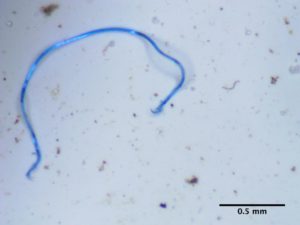 It turns out that it rains tons and tons of tiny pieces of plastic each year! These tiny pieces of plastic, called microplastics, are carried like dust in the wind and air currents around the earth, and eventually come down like dust. Or particles from nearby urban areas can come down in rain, storms, and snow.
It turns out that it rains tons and tons of tiny pieces of plastic each year! These tiny pieces of plastic, called microplastics, are carried like dust in the wind and air currents around the earth, and eventually come down like dust. Or particles from nearby urban areas can come down in rain, storms, and snow.
Researchers from a study looking at dust and rainwater samples in 11 western United States parks estimate that more than 1000 tons of this stuff fall each year just on this area alone. They estimate that 4% of the dust deposited on the land had microplastics in them, and nearly all samples had microplastics in them. The researchers found that an average of "132 plastics per square meter" was deposited each day. Yikes!
Where does it come from? Most of the microparticles were microfibers that came from synthetic textiles used for clothing (shed when worn or from washing, drying) and carpeting. But also industrial processes, outdoor equipment, industrial paints and coatings). Since plastics are persistant, they break up into little pieces over time and become microplastics.
Which means tons and tons more of these microplastics are falling on the rest of the United States and world, including us. How much are we breathing in? And what, if anything, is it doing to us?
So far studies have found microplastics in foods, drinking water, estimates of humans ingesting more than 74,000 microplastics each year, that we are breathing them in, and that they are found in human stool . Also, it is known that microplastics can accumulate and harm wildlife, and can move up the food chain.
It doesn't look good for us as plastic production (348 million metric tons of plastic produced worldwide in 2017) and plastics in the environment keep increasing. We need to address this problem. Now.
Excerpts from a good article on this study: A threat from above: Plastic rains down on US National Parks and Wilderness areas
Last August, scientists delivered the chilling news that microplastics suspended in the Earth's atmosphere were being deposited in remote areas of the Arctic and Europe. Now researchers report similar microplastic accumulation in iconic American protected areas including the Grand Canyon and Joshua Tree.
Publishing their results today in Science, the researchers estimate total yearly plastics deposition over their study area to be the equivalent of 123 to 300 million discarded water bottles.
After observing the magnitude of the atmospheric plastic deposition, Brahney's team wanted to figure out where it was coming from. They compared the rates of deposition that they observed with models of atmospheric circulation patterns. They found that microplastics that were deposited in wet conditions seemed to be originating from nearby urban centers, perhaps when a rainstorm traveled through a city and then moved out to the park or wilderness area.
However, dry deposition rates (which represent 75 percent of total plastics delivered to the conservation areas) seemed driven more by the behavior of the Polar jet stream—an air current that circles the Earth several miles above the surface.
This implies that microplastics could have been transported to U.S. protected areas from much farther away, including other continents.
For more details, from Science Daily: More than 1000 tons of plastic rains into Western US protected lands annually
